
JULIA LEE BARCLAY-MORTON – YOGA, WATER AND REWRITING AUTISM
I interviewed writer Julia Lee Barclay-Morton about her experience of autism. Julia began as an experimental dramatist in New York, moving to the UK to
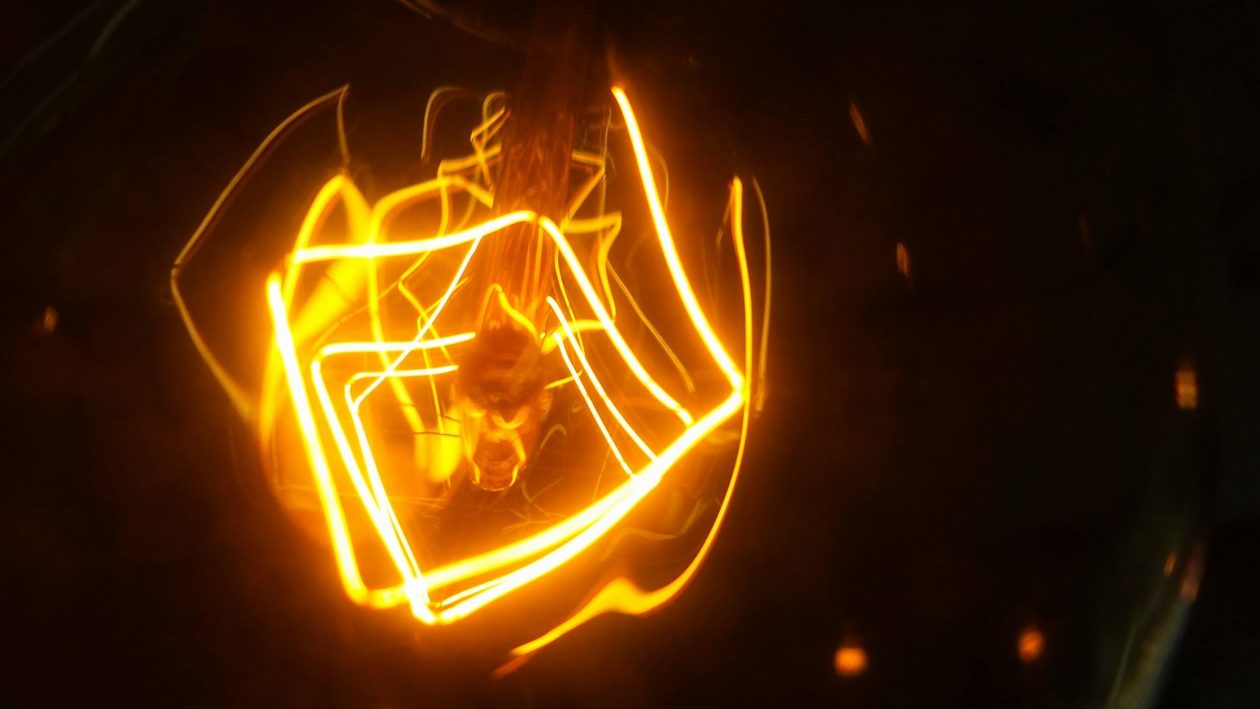
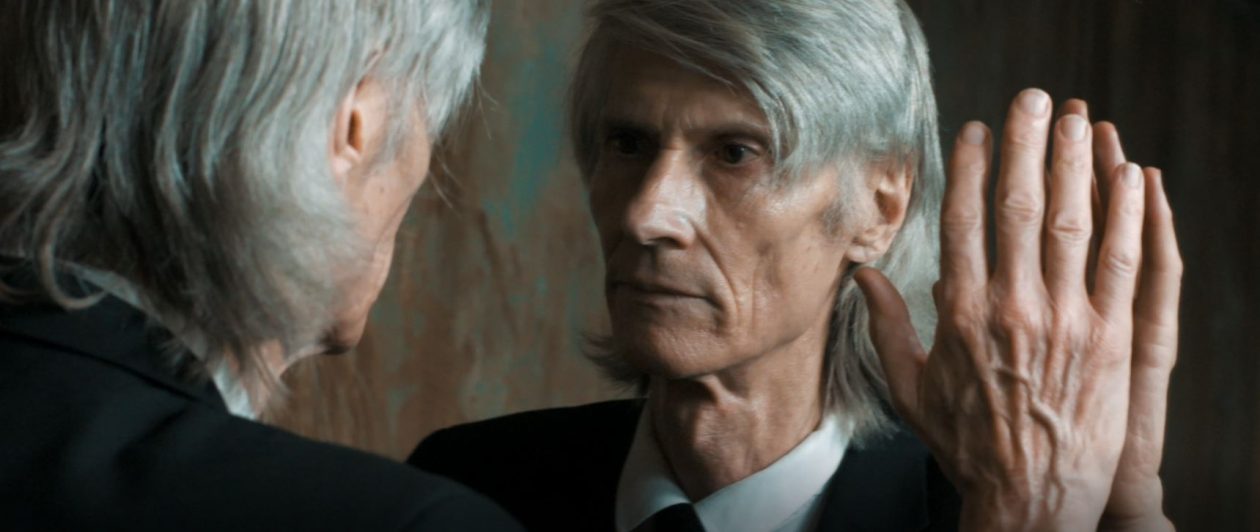
The newly-released film Heaven’s Rage is a story of self-discovery: of soul lost and found, and the truth behind everyday appearances. Based on my memoir of the same name, the film explores ‘Burning questions, hidden feelings and pressures to conform’.
It was made by:
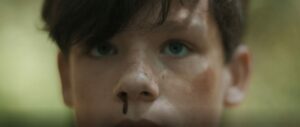
Here is the story of making that film:
‘We filmed the first full day of Heaven’s Rage in a sunny wood on the outskirts of Watford. We’d taken a winding, potholed road to get there, passing through stretches of fenced-off wasteland and scrubby undergrowth, then a concrete tunnel beneath a motorway, to arrive at cottages surrounded by sunspots and greenery. The drive was short but varied, changing from town to country, from noise and action to enclosed space, from dusty main roads to a shaded country lane. It was as if we’d taken a back route to a forgotten childhood territory where anything might happen.
There were five of us: Mark, the director; James on camera; Daniel child-actor; Daniel’s mother, Amanda; and me. Arriving in three cars, we parked by a fence just beyond a boarded-up cottage and James unloaded his equipment. With the help of Mark he carried a lens bag, a ladder-like tripod, two large stands and a heavy black camera to a place opposite the cottage. Setting up the equipment took several minutes; when fully assembled it looked like an imaginary AI machine.
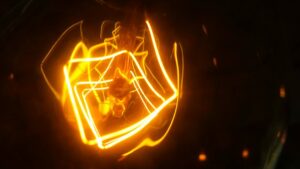
We’d filmed one scene the night before. Using blackout curtains to seal off Mark’s living room, we’d created a dream world with James in one half, taking pictures of me behind a table, wearing a white shirt and black suit and tie. Mark’s wife, Sheelagh, was there, watching from the side, while Mark himself was teasing out wire wool from a package, coiling the black, fibrous material into a wine glass. His thin, agile hands moved quickly, shaping it to fit.
“A trick I learned in special effects,” he said.
“Let’s see how it burns,” he added, striking a match.
When the flame touched the wool, the red glow spread in patches, reaching the ends and curling like singed hair.
“Oh, I love that, it’s so magical,” said Sheelagh.
Reflected in the glass, the wool looked like a red-hot mineral.
The drink scene took the rest of the evening. Mark directed, offering verbal prompts, checking his storyboard and rustling up props. His role, as répétiteur, was to tweak everything. Sheelagh had taken charge of the metal wool, which she tugged and smoothed into layers. James, carrying the camera in a fireman’s lift, was adjusting focus and calling ‘action’.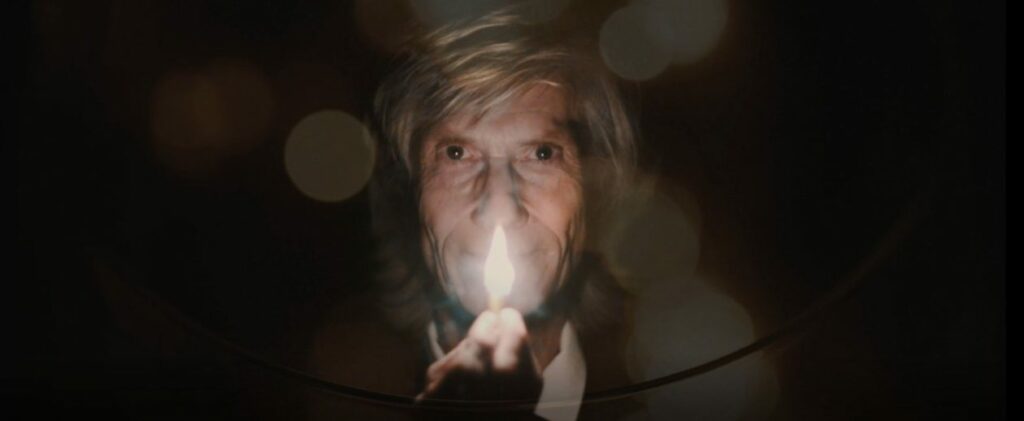 The action of the drink scene involved me striking bunches of matches and raising them to my face. The air felt charged, as if I was holding a blowtorch. With the glass burning by my elbow, I was inside a restricted territory, a kind of lit-up frame in space. It was odd and slightly disturbing – dangerous even – because viewed back on camera, the fire seemed to be eating my skin. I was in another world, a chthonic figure absorbed by his own obsession.
The action of the drink scene involved me striking bunches of matches and raising them to my face. The air felt charged, as if I was holding a blowtorch. With the glass burning by my elbow, I was inside a restricted territory, a kind of lit-up frame in space. It was odd and slightly disturbing – dangerous even – because viewed back on camera, the fire seemed to be eating my skin. I was in another world, a chthonic figure absorbed by his own obsession.
Filming in the woods next morning was a different story. Watching the process, I saw myself through another person’s eyes. Mark directed as Daniel pushed along an overgrown path to stand in front of the boarded-up cottage, waving. Wearing my tie and jacket, he looked like a fresh-faced version of my former self, or the child I might have been if I’d grown up in 2017 instead of the 1950s.
At thirteen, Daniel was an experienced actor whose curly-haired innocence was matched by his adult understanding. He was camp, affectionate and worldly-wise. Physically, he was fluid in an intermediate way, so his body was boyish but rounded, while his face had both charm and a male directness – he was straight and attentive and gently playful. Several times during the shoot I thought, ‘If only I’d been like that!’
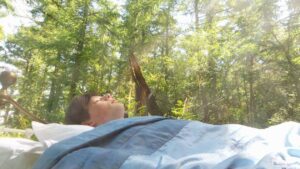 In the course of a day’s filming we were scratched by brambles and stung by nettles as we carried our props – including a bedframe, mattress and sheets – over ditches and dead branches into quiet forest clearings. The sets we created were carefully put together; they had clarity and edge plus a deliberate wildness – matching the film’s clean surfaces and surprising juxtapositions. At the centre of each, posed and positioned by Mark, was Daniel playing me: a boy-girl waking in bed in a forest fantasy, or tied by bullies to a tree wearing a red dress, as in my short story A Dream.
In the course of a day’s filming we were scratched by brambles and stung by nettles as we carried our props – including a bedframe, mattress and sheets – over ditches and dead branches into quiet forest clearings. The sets we created were carefully put together; they had clarity and edge plus a deliberate wildness – matching the film’s clean surfaces and surprising juxtapositions. At the centre of each, posed and positioned by Mark, was Daniel playing me: a boy-girl waking in bed in a forest fantasy, or tied by bullies to a tree wearing a red dress, as in my short story A Dream.
We broke for lunch at 2.30pm. By then I’d been crouched on a log too hungry to do anything, until Mark noticed and sent me to his car with the keys.
“There’s some fruit in the boot,” he’d called. ‘Please, do help yourself.”
At the car, after stuffing down a banana and three apples, I chatted to Amanda, who’d volunteered to guard the unused equipment. She told me about Daniel: the roles he’d played, his gay self-acceptance, his close friendships and support at school. As we talked, the sun shone in pools and streaks across the forest floor. When our conversation stopped, birdsong took over. The air was warm and still, and the light was high. It was quiet, we were there waiting in the woods and the film was progressing…
Over that weekend I experienced the full, behind-the-scenes impact of film-making. It resembled trekking, weighed down by kit, on a winding path where each stretch could take anything from a few minutes to several hours. The kit involved costumes, props, stands, lights, batteries, lenses, laptops and numerous other bits and pieces including food, drink, gaffer tape and call sheets. It was easy to leave something behind, drop it, or get lost – the latter involving cars separated, chasing each other or long waits while Mark went scouting. The locations took hours to fix or disguise or set up outdoors, with problems over lighting and composition; while the actions involved repeated takes of the same short scene. Coupled with the demanding schedule, exacting photography and so few helpers, it could only lead to long waits, sudden switches and lots of confusion… Indie filming, I learned, was a life on the brink, ever-shifting, lived out of bags, and chaotic.
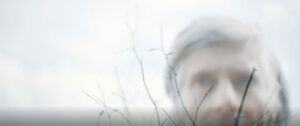 But the dream kept us going. So the mud-mound where we filmed in the local park doubled as a dry stream bed, and the woods we used – a strip on the edge of a busy motorway – became part of untouched, rural England. Even indoors, we ‘dressed the set’ with fake floorboards, unreal lighting and full-length mirrors. Anything was possible, and each scene was a try-on and a lucky-dip experiment – though it was also an escape to a different mind-set. Because our film was about vision and deep psychology. It was a hall of mirrors where we continually ‘cheated reality’, framing the shots to trick our audience and set up their dream.
But the dream kept us going. So the mud-mound where we filmed in the local park doubled as a dry stream bed, and the woods we used – a strip on the edge of a busy motorway – became part of untouched, rural England. Even indoors, we ‘dressed the set’ with fake floorboards, unreal lighting and full-length mirrors. Anything was possible, and each scene was a try-on and a lucky-dip experiment – though it was also an escape to a different mind-set. Because our film was about vision and deep psychology. It was a hall of mirrors where we continually ‘cheated reality’, framing the shots to trick our audience and set up their dream.
In fact, there were two films. There was the non-linear adaptation of my memoir Heaven’s Rage, and another, more domestic story, involving my day-to-day relationship. This second story was about love and long-term commitment and the gap between feelings and life. Because to be on the shoot I’d had to leave Sue, my wife, recovering from day surgery with pre-prepared food and a couple of scheduled visits. It seemed typically male and disloyal but Sue wanted it, and I’d done everything I could at hospital and at home – although at a deeper level I knew she feared being alone, and during the filming I received more than one text telling me how ill she was.
So the two films ran on, side by side, as if they were the same story being shown in different languages or different chapters taken from the same book. In my Sue-film the location was the bedroom, the shots were of hands on pills and spills on trays, while the dialogue was fitful. There were moments where I sat on the bed and we chatted about news and friendships and Sue’s latest symptoms, and other times when we talked, between long pauses, about how to manage pain. To an outsider it might have seemed quite couply, with me playing nurse and Sue eating or resting, but the hidden doubts and tensions were there, running around our heads.
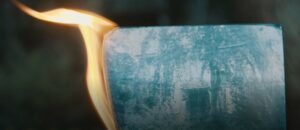 Firstly, there was the issue of earning a ‘pass out’, a practice I’d been used to as a parent but involving a lot of extra work, some of it for show. Secondly, and more importantly, I was struggling with a fatiguing condition that the doctors couldn’t diagnose. Thirdly there was Sue’s fear of abandonment, that illness made her unattractive and would drive me away. Fourthly we were in love and unprepared for what felt like separation. Fifthly, and crucially, Sue was ill.
Firstly, there was the issue of earning a ‘pass out’, a practice I’d been used to as a parent but involving a lot of extra work, some of it for show. Secondly, and more importantly, I was struggling with a fatiguing condition that the doctors couldn’t diagnose. Thirdly there was Sue’s fear of abandonment, that illness made her unattractive and would drive me away. Fourthly we were in love and unprepared for what felt like separation. Fifthly, and crucially, Sue was ill.
So the slow-paced Sue-film was a documentary, leaving the audience to guess at the actors’ moods. It was a series of stills, a quiet, nagging companion piece to Heaven’s Rage, running on regardless with its own private fears and internal imaginings that threatened to undermine everything.
Making a film took longer than expected. The overrun was needed to work on Mark’s sketches and shape them into finished cinema. It was a fiddly, trial-and-error job, shifting and changing everything before running and re-running the camera through several takes, all of them requiring further changes before moving on to the next.
“I won’t shoot shit,” James declared, as he waved me back and forth until I was standing just where he wanted, head-on to the camera.
“Step back a bit,” he said quietly, gazing down the viewfinder.
“Forward again,” he called.
“Hold it there,” he added, gently, “still as you can.”
By the time we’d filmed it, a few seconds of footage had taken nearly two hours to shoot.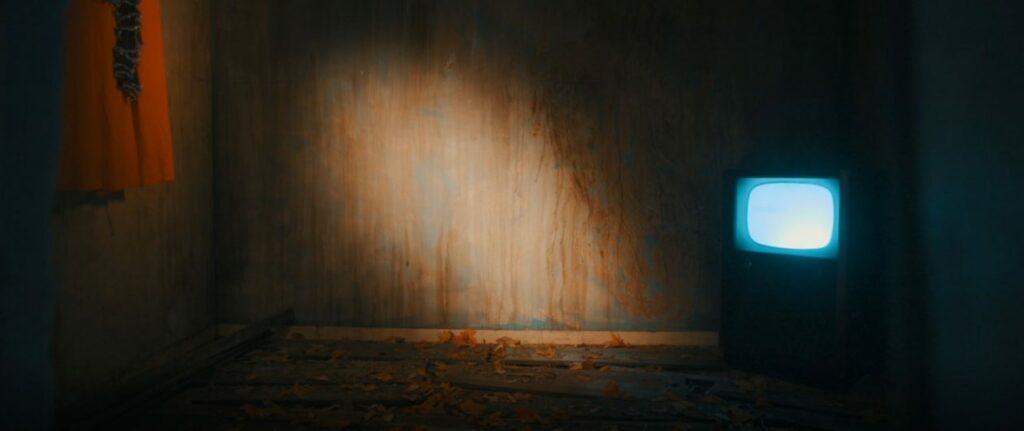 It took six days, working twelve hours a day, to film Heaven’s Rage. There were stops and starts and occasional disagreements with James as ‘down-to-earth craftsman’, challenging Mark as ‘arthouse dreamer’ to explain the aim of each shot. In this debate, while James stood for realism, Mark wanted poetry and surprise. The result was an argument, gentle at first but escalating later, in which I played peacemaker, asking about the industry and their stories of joshing and abuse. In fact I didn’t need to. As friends and co-creatives, Mark and James were quite unlike the film-set bullies they talked about, and the tensions that surfaced were the result of tiredness and lack of a crew.
It took six days, working twelve hours a day, to film Heaven’s Rage. There were stops and starts and occasional disagreements with James as ‘down-to-earth craftsman’, challenging Mark as ‘arthouse dreamer’ to explain the aim of each shot. In this debate, while James stood for realism, Mark wanted poetry and surprise. The result was an argument, gentle at first but escalating later, in which I played peacemaker, asking about the industry and their stories of joshing and abuse. In fact I didn’t need to. As friends and co-creatives, Mark and James were quite unlike the film-set bullies they talked about, and the tensions that surfaced were the result of tiredness and lack of a crew.
But watching back the footage was a lift. It was as if we were on location in the mind of the reader, seeing for real the characters in my book.
By the last full day of filming we were quicker: debating less, doing more. We felt freer and less pressured because the difficult scenes were over and what remained seemed doable. So we put on a spurt. James called ‘action’ and suddenly, before we knew it, the end was in sight and we shot the final scene by a streetlamp, surrounded by hedges on a warm night with moths in the air.
It was there, at the centre of a softly-lit circle where four paths met, that we worked on the ‘reveal’. It came in one take. As my head went back, I reached up, and the camera closed on my hidden feelings. Inside was the child and the suited man burning up; outside was me: the cross-dressed author. And behind that was Sue, walking with me into sunlight, speaking of love and calling me her beautiful boy…
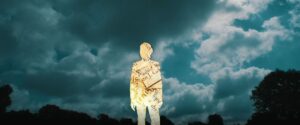 There was a postscript, of course. Like writing, the film needed many hours of editing, cutting, special effects and joining at the edges. Mark had to record readings, live music and sound effects to fit to the frames. He and James worked late into the night to shape it all and produce a final copy. In the end the Sue-story and the film of the book merged.
There was a postscript, of course. Like writing, the film needed many hours of editing, cutting, special effects and joining at the edges. Mark had to record readings, live music and sound effects to fit to the frames. He and James worked late into the night to shape it all and produce a final copy. In the end the Sue-story and the film of the book merged.
So what did the final cut look like? Heaven’s Rage had become a collection of:
And in Mark and James my story had found two gifted, creative friends and interpreters.
Their film was my dream.’
Leslie Tate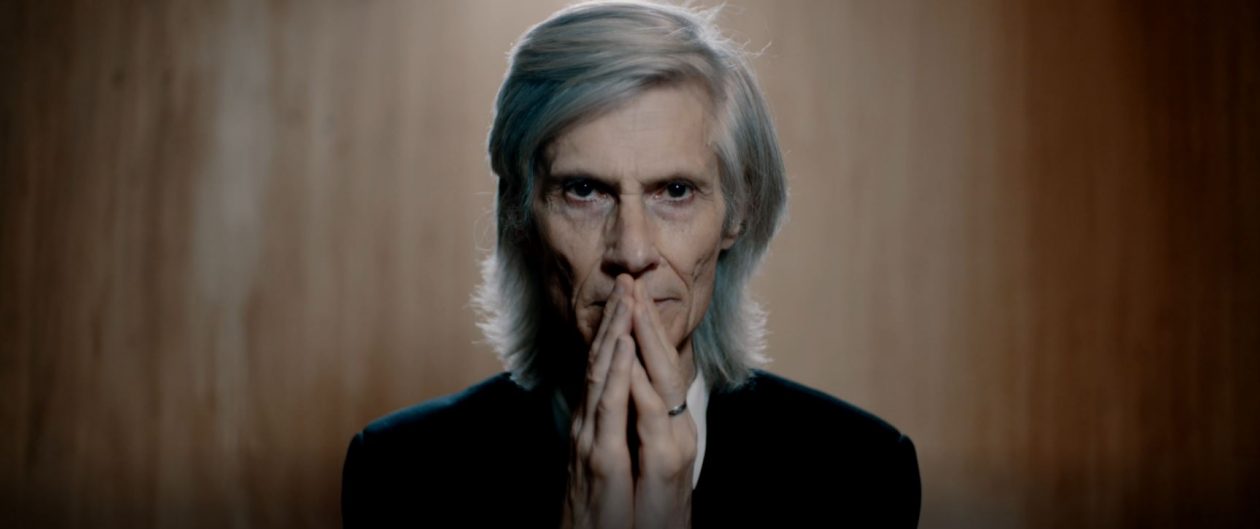
Next week, in PLAYING THE PEOPLE’S MUSIC, I interview grassroots musicians Kim and Martin Olyett about their passion for traditional folk.
ABOUT LESLIE TATE’S BOOKS:

I interviewed writer Julia Lee Barclay-Morton about her experience of autism. Julia began as an experimental dramatist in New York, moving to the UK to

I interviewed Gillean McDougall from Glasgow, who edited the collaborative projects Honest Error (on Charles Rennie Mackintosh and his wife Margaret Macdonald) and Writing the

I interviewed French writer Delphine de Vigan, whose book, No et moi, won the prestigious Prix des libraires. Other books of hers have won a clutch

I interviewed Joanne Limburg whose poetry collection Feminismo was shortlisted for the Forward Prize for Best First Collection; another collection, Paraphernalia, was a Poetry Book Society Recommendation. Joanne

I interviewed Katherine Magnoli about The Adventures of KatGirl, her book about a wheelchair heroine, and Katherine’s journey from low self-esteem into authorial/radio success and
| Cookie | Duration | Description |
|---|---|---|
| cookielawinfo-checkbox-analytics | 11 months | This cookie is set by GDPR Cookie Consent plugin. The cookie is used to store the user consent for the cookies in the category "Analytics". |
| cookielawinfo-checkbox-functional | 11 months | The cookie is set by GDPR cookie consent to record the user consent for the cookies in the category "Functional". |
| cookielawinfo-checkbox-necessary | 11 months | This cookie is set by GDPR Cookie Consent plugin. The cookies is used to store the user consent for the cookies in the category "Necessary". |
| cookielawinfo-checkbox-others | 11 months | This cookie is set by GDPR Cookie Consent plugin. The cookie is used to store the user consent for the cookies in the category "Other. |
| cookielawinfo-checkbox-performance | 11 months | This cookie is set by GDPR Cookie Consent plugin. The cookie is used to store the user consent for the cookies in the category "Performance". |
| viewed_cookie_policy | 11 months | The cookie is set by the GDPR Cookie Consent plugin and is used to store whether or not user has consented to the use of cookies. It does not store any personal data. |
12 responses
I am delighted for you. Co congratulations
Thank you, Susan, that’s so kind!
It sounds a beautiful film, reminding me, through your narration of Pan’s Labyrinth. Dream sequences and real-life interwoven. I will wait patiently until we in the north can see the movie. Good luck and all the best wishes in the world for this to become a hit.
Thank you so much, Adele. We’re entering the film for competitions and festivals. Some of them will be closer to you. I’ll try to keep you posted
A very interesting read, Les. Would love to see this film version. How long does it run? I’ve been involved in making shorts myself. Very exhausting and creative at the same time.
Thanks, Barbara. It’s 14.5 minutes long – which sounds so short, but really it’s intense, emotional and very compressed – edited down from 100 hours, with special effects, music behind words and period props that took some finding! I think you’ll understand, from your experience. I believe Mark is going to have an available version either to download or on CD. He’s working very hard now but we’ll advertise what’s available when we’ve showed the premiere. Thanks again, you’re so right about the exhausting/creative!
All the best with your wee film Leslie, and well done to you, Sue and the film crew!
🙂 🙂 🙂
Wonderful!
Congratulations to the team.
Leslie, the boy, has found multiple paths to self-expression, integrity and peace.
Yes, everyone worked so hard, especially Mark. He wanted to shoot in a derelict house, couldn’t get inside one, so he changed the old room he grew up in to a shell – and he’s had to restore it. A complete redecoration/refit in the middle of editing. Thank you, Michelle. xxxx
Good luck with the reviews and sales!
Thanks, Sarah, that’s really kind of you!